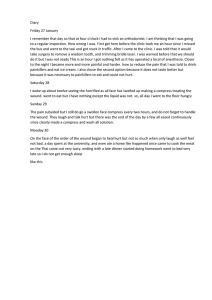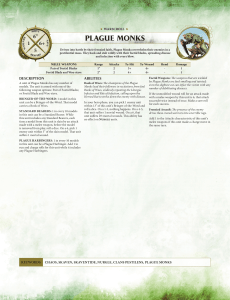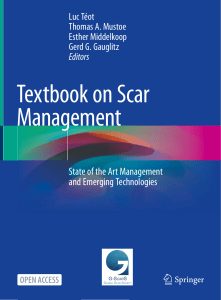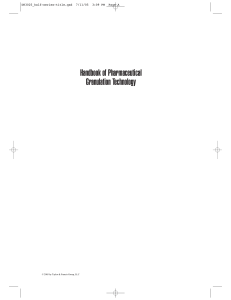Влияние терапии отрицательным давлением на
реклама
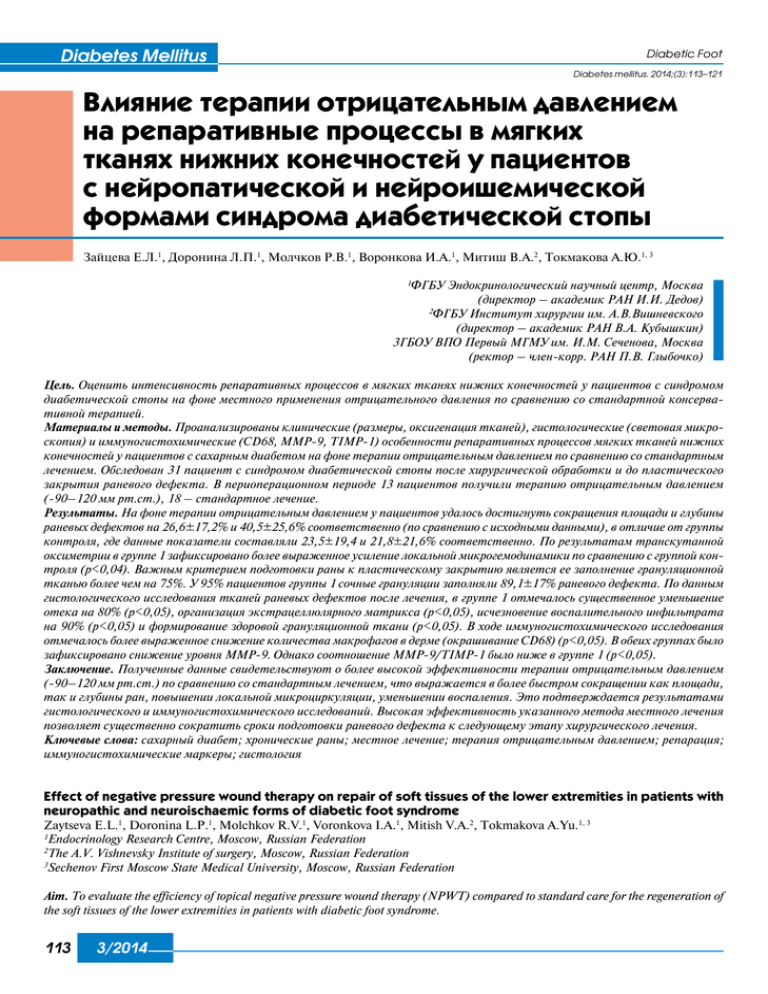
Diabetes Mellitus Diabetic Foot Diabetes mellitus. 2014;(3):113–121 Влияние терапии отрицательным давлением на репаративные процессы в мягких тканях нижних конечностей у пациентов с нейропатической и нейроишемической формами синдрома диабетической стопы Зайцева Е.Л.1, Доронина Л.П.1, Молчков Р.В.1, Воронкова И.А.1, Митиш В.А.2, Токмакова А.Ю.1, 3 1 ФГБУ Эндокринологический научный центр, Москва (директор – академик РАН И.И. Дедов) 2 ФГБУ Институт хирургии им. А.В.Вишневского (директор – академик РАН В.А. Кубышкин) 3ГБОУ ВПО Первый МГМУ им. И.М. Сеченова, Москва (ректор – член-корр. РАН П.В. Глыбочко) Цель. Оценить интенсивность репаративных процессов в мягких тканях нижних конечностей у пациентов с синдромом диабетической стопы на фоне местного применения отрицательного давления по сравнению со стандартной консервативной терапией. Материалы и методы. Проанализированы клинические (размеры, оксигенация тканей), гистологические (световая микроскопия) и иммуногистохимические (CD68, MMP-9, TIMP-1) особенности репаративных процессов мягких тканей нижних конечностей у пациентов с сахарным диабетом на фоне терапии отрицательным давлением по сравнению со стандартным лечением. Обследован 31 пациент с синдромом диабетической стопы после хирургической обработки и до пластического закрытия раневого дефекта. В периоперационном периоде 13 пациентов получили терапию отрицательным давлением (-90–120 мм рт.ст.), 18 – стандартное лечение. Результаты. На фоне терапии отрицательным давлением у пациентов удалось достигнуть сокращения площади и глубины раневых дефектов на 26,6±17,2% и 40,5±25,6% соответственно (по сравнению с исходными данными), в отличие от группы контроля, где данные показатели составляли 23,5±19,4 и 21,8±21,6% соответственно. По результатам транскутанной оксиметрии в группе 1 зафиксировано более выраженное усиление локальной микрогемодинамики по сравнению с группой контроля (p<0,04). Важным критерием подготовки раны к пластическому закрытию является ее заполнение грануляционной тканью более чем на 75%. У 95% пациентов группы 1 сочные грануляции заполняли 89,1±17% раневого дефекта. По данным гистологического исследования тканей раневых дефектов после лечения, в группе 1 отмечалось существенное уменьшение отека на 80% (p<0,05), организация экстрацеллюлярного матрикса (p<0,05), исчезновение воспалительного инфильтрата на 90% (p<0,05) и формирование здоровой грануляционной ткани (p<0,05). В ходе иммуногистохимического исследования отмечалось более выраженное снижение количества макрофагов в дерме (окрашивание CD68) (p<0,05). В обеих группах было зафиксировано снижение уровня ММР-9. Однако соотношение MMP-9/TIMP-1 было ниже в группе 1 (p<0,05). Заключение. Полученные данные свидетельствуют о более высокой эффективности терапии отрицательным давлением (-90–120 мм рт.ст.) по сравнению со стандартным лечением, что выражается в более быстром сокращении как площади, так и глубины ран, повышении локальной микроциркуляции, уменьшении воспаления. Это подтверждается результатами гистологического и иммуногистохимического исследований. Высокая эффективность указанного метода местного лечения позволяет существенно сократить сроки подготовки раневого дефекта к следующему этапу хирургического лечения. Ключевые слова: сахарный диабет; хронические раны; местное лечение; терапия отрицательным давлением; репарация; иммуногистохимические маркеры; гистология Effect of negative pressure wound therapy on repair of soft tissues of the lower extremities in patients with neuropathic and neuroischaemic forms of diabetic foot syndrome Zaytseva E.L.1, Doronina L.P.1, Molchkov R.V.1, Voronkova I.A.1, Mitish V.A.2, Tokmakova A.Yu.1, 3 1 Endocrinology Research Centre, Moscow, Russian Federation 2 The A.V. Vishnevsky Institute of surgery, Moscow, Russian Federation 3 Sechenov First Moscow State Medical University, Moscow, Russian Federation Aim. To evaluate the efficiency of topical negative pressure wound therapy (NPWT) compared to standard care for the regeneration of the soft tissues of the lower extremities in patients with diabetic foot syndrome. 113 3/2014 Diabetic Foot Diabetes Mellitus Diabetes mellitus. 2014;(3):113–121 Materials and methods. The effects of negative pressure therapy on the clinical (size, tissue oxygenation), histological (light microscopy) and immunohistochemical (CD68, MMP-9, TIMP-1) aspects of repair of the soft tissue of the lower extremities in patients with diabetes mellitus were compared to those who recieved standard management. Thirty-one patients with diabetic foot ulcers were included in the study from the moment of debridement until the plastic closure of the wound. During the perioperative period, 13 patients received NPWT (-90 to -120 mmHg) and 18 patients received standard therapy. Results. A reduction of the wound area (26.6%±17.2%) and the depth of the defects (40.5%±25.6%) were achieved with NPWT compared with baseline data. In the control group, the corresponding values were 25.3%±19.4% and 21.8%±21.6%, respectively. The results of transcutaneous oxygen monitoring showed a greater increase of the level of local perfusion in the study group (p <0.04). An important criterion for wound preparation for a plastic closure is filling it with granulation tissue by more than 75%. In the study group, 95% of patients had wounds were with 89.9%±17% of mature granulation tissue. The histological data of the study group show a significant reduction of oedema by 80% (p <0.05), improved extracellular matrix organization (p <0.05), 90% (p <0.05) dissolution of inflammatory infiltrate and the formation of healthy granulation tissue (p <0.05). Immunohistochemical analysis demonstrated a significant decrease in the number of macrophages in the dermis (CD68 expression) (p <0.05). In both groups, the level of MMP-9 was decreased. However, the ratio of MMP-9/TIMP-1 was lower in the study group (p <0.05). Conclusion. The findings suggest that negative pressure therapy (-90 to -120 mmHg) is more effective compared to standard treatment and achieves more rapid reduction of the area and depth of the wound, increases local microcirculation and decreases inflammation. These findings were confirmed histologically and immunohistochemically. The high efficiency of this method significantly reduced the time required for preparing the wound for the next surgical treatment. Keywords: diabetes mellitus; chronic wounds; local treatment; negative pressure wound; tissue repair; immunohistochemical markers; histology DOI: 10.14341/DM20143113-121 hronic wounds of the lower extremities may occur in 25% of patients with diabetes mellitus (DM), which is responsible for 20% of their hospital admissions and often leads to amputation [1]. Within 5 years, 50% of previous surgical patients require amputation of the contralateral limb. Therapy in chronic wounds of patients with diabetes is characterized by long duration, complexity, high cost and uncertain prognosis and may not achieve healing. In patients with prolonged and poorly controlled DM, wound healing is slow due to low levels of local growth factors and micro- and macrovascular complications. Diminished peripheral sensation, impaired local perfusion and chronic hyperglycaemia increase the risk of developing diabetic ulcers that may become infected [2]. Hyperglycaemia and protein glycation play critical roles in impaired healing. In patients with DM, there is evidence for the disregulation of growth factor synthesis [3], changes in angiogenesis and collagen accumulation, impairment of epidermis barrier function and low quality of granulation tissue [4]. The disruption of keratinocyte and fibroblast migration and nerve regeneration [5] are associated with an imbalance between the accumulation of the extracellular matrix and its remodelling via matrix metalloprotease [6]. Wounds in patients with diabetes usually have a longer phase of inflammation, decreased activity of inflammatory cells and slower restructuring of the extracellular matrix (ECM). These conditions facilitate the transformation of an acute wound into a chronic condition [7]. C Macrophages play the primary role in healing during the inflammatory phase. Macrophages produce platelet-derived growth factor (PDGF), fibroblast growth factor (FGF), transforming growth factors (TGFs) and granulocyte-macrophage colony stimulating factor (GM-CSF) [8] that promote healing by mediating the organization of the extracellular and collagen matrices. During the transition to the proliferative phase of healing, the quantity of macrophages decreases and keratinocytes migrate into the wound bed where the interaction between matrix metalloproteases (MMPs), integrins and cytokines mediate the production of ECM [3]. MMP levels significantly affect wound healing through the deceleration of the restructuring of the extracellular and collagen matrices. High levels of MMP-9 in the wound exudate is a marker of inflammation and impaired wound healing in patients with DM [9]. During efficient wound healing in patients with DM, the ratio of MMP-9 to the tissue inhibitor of metalloproteinase–1 (TIMP-1) in the wound exudate decreases, but remains elevated in patients with poor healing of ulcers [10, 11]. Negative pressure wound (vacuum therapy, VAC, NPWT) is used successfully in treatment of different types of wounds, presumably by accelerating healing. Several hypotheses explain the efficacy of this method as follows: reduction of wound size, stabilization of the wound environment (by removing inflammatory mediators and cytokines), reduction of bacterial contamination, reduction of oedema by removing the exudate and stimulation of healing through cellular microdeformation [12]. However, the data are most often based on some case reports or laboratory studies. 3/2014 114 Diabetes Mellitus Diabetic Foot Diabetes mellitus. 2014;(3):113–121 Table 1 Clinical and laboratory characteristics of patient groups Character Age, years DM type (1/2) DM duration, years HbA1c, % Cholesterol, total mmol/l Hdl, mmol/l Cholesterol, ldl mmol/l Triglyceride (TG), mmol/l Haemoglobin, g/l Leukocytes, 109/l Serum protein, total, g/l GFR (MDRD), ml/min/1.73 m2 Wound area, cm2 Wound depth, cm Wagner diabetic ulcer scale, number of patients: Grade 2 (%) Grade 3 (%) Foot soft tissue oxygenation, mm Hg Despite the positive clinical effects of VAC, the molecular mechanism of the tissue processes (including in patients with DM) is not fully understood. There is published evidence indicating that by the end of the negative pressure wound period, there is increased vascular density and expression of the endothelial-cell marker CD31, decreased expression of macrophage-specific CD68 and lymphocytespecific CD45. These processes indicate the transition to the epithelialisation phase in wound healing (determined using immunohistochemistry, IHC) and according to clinical observations. Aim The objective of this study was to evaluate the effect of negative pressure wound on the soft tissues of patients with diabetic foot syndrome (DFS) compared with that of standard treatment. Materials and methods Thirty-one patients with neuropathic and neuroischaemic forms (after revascularization) of DFU were included in the study (10 females and 21 males). All patients underwent wound debridement. In the study group (group 1), 13 patients received NPWT (-90 to -120 mmHg) (VivanoTec, Hartmann, Germany) during 8 ± 4 days of the preoperative period before plastic closure. Wound size and condition were checked every 3–4 days when the wound dressings were changed. The 18 patients were in the control group (group 2) and standard care as follows: daily changes of an atraumatic dressing (Inadin, Systagenix; Silcofix, Povi). The filling of the wound with granulation tissue by at least 75% was used as a criterion of wound preparation for plastic closure. A 115 3/2014 Group 1 (n=13) 55.3 ± 12 3/10 18.31 ± 8.36 9.2 ± 1.8 3.39 ± 0.71 0.70 ± 0.13 1.84 ± 0.61 1.64 ± 0.61 105.13 ± 9.3 10.81 ± 2.42 64.3 ± 4.2 78.3 ± 32.0 35.8 ± 26 4.05 ± 2.79 Group 2 (n=18) 59.2 ± 9 1/17 12.17 ± 6.03 9.0 ± 1.5 4.05 ± 0.96 0.73 ± 0.16 2.44 ± 0.81 1.62 ± 0.45 102.8 ± 8.1 11.35 ± 1.46 65.2 ± 3.7 86.0 ± 33,0 37.0 ± 25 3.57 ± 1.8 p-value >0.05 >0.05 <0.05 >0.05 >0.05 >0.05 >0.05 >0.05 >0.05 >0.05 >0.05 >0.05 >0.05 >0.05 7 (54) 6 (46) 33.7 ± 17 7 (39) 11 (61) 32.1 ± 17.8 >0.05 >0.05 wound-edge biopsy was collected from all patients for histological and IHC studies before and after treatment. The patients in both groups were comparable by age, glycaemic control, severity of diabetic complications, DFU type, wound area and depth and lower limb blood supply (p > 0.05). The groups did not differ significantly according to the duration of DM. Before treatment, histological and IHC analyses of biopsy samples after debridement demonstrated that repair was comparable in patients of both groups. Patients in both groups had marked oedema, poorly organized extracellular matrix (ECM), a small content of fibroblastlike cells, a severe inflammatory infiltrate (p < 0.05), high levels of CD68 and MMP-9 and low levels of TIMP-1 expression. These results confirm stagnation of repair in the soft tissues in both groups. All blood tests were performed according to the standard protocols of the Endocrinology Research Centre, Laboratory of Biochemistry (Chief Il’in A.V.). Wound area was determined by delineating the contours of the wound through a transparent film (Opsite Flexigrid, Smith and Nephew) followed by the calculation of the inner area according to special equations. A Radiometer (Denmark) unit was used for transcutaneous oxygen monitoring. Sensors were placed 0.5–1 cm from wound edges. Morphological studies were performed at the Department of Pathology, Endocrinology Research Centre (Acting Department Head, F.M. Abdulhabirova, MD, PhD). Biopsy materials were observed by histological and IHC analyses before and after the treatment. Tissues were fixed in 10% formalin and processed for paraffin embedding. Serial sections 3–5-μm thick were deparaffinised and stained Diabetes Mellitus Diabetic Foot Diabetes mellitus. 2014;(3):113–121 Wound surface dynamics Wound depth dynamics 40 35 30 mm cm2 25 20 15 10 5 0 Group 1 p>0,05 45 40 35 30 25 20 15 10 5 0 p<0,05 Group 2 Granulation tissue growth 60 100 50 80 40 60 % мм рт.ст. Local microcirculation dynamics 30 40 20 20 10 0 p>0,05 Group 2 Group 1 0 Group 1 Group 2 before treatment p<0,05 Group 1 Group 2 after treatment Figure 1. Wound defects clinical condition. with hematoxylin and eosin. Accepted principles of quantitative analysis were used for the assessment of histological criteria of inflammation, regeneration and condition of granulation tissue. IHC analyses were performed using a Leica BOND– MAX Immunostainer. The following antibodies were used and purchased from Dako: TIMP-1, MMP-9 and macrophage marker CD68. Expression levels (percentage of cells stained) were scored as follows: 1+, <30%; 2+, >30–60%; 3+, 60–90% and 4+, >90%. The study design was comparative. The Ethics Committee of the Endocrine Research Centre approved the study protocol on 28 November 2012. All patients were required to sign a legal informed consent form to participate in the study. Statistical analysis was performed using Statistics 7.0 software (Stat–Soft). The Mann–Whitney test and Fisher’s exact test were used to compare quantitative and qualitative parameters, respectively. Values are expressed as the average and standard deviation. Spearman correlation analysis was used. The null hypothesis was rejected if p ≤ 0.05. Results The course of the clinical condition of wound defects after 8 ± 4 days of therapy is shown in Figure 1. Negative pressure wound achieved a reduction of wound area and depth by 26.6% ± 17.2% and 40.5% ± 25.6%, respectively, compared to baseline (p < 0.05). In the control group, the respective values were 23.5% ± 19.4% and 21.8% ± 21.6% (p < 0.005). Unlike the wound depth dynamics, wound area dynamics were not significantly different between the groups (p = 0.064). Patients who received NPWT a significant reduction in the depth of the wound compared to those in the control group (p = 0.037). According to the results of transcutaneous oxygen monitoring, patients in group 1 had a more severe increase of local perfusion as compared to the control group (p < 0.05). Plastic closure can be performed when the wound bed is filled with more than 75% of granulation tissue. In group 1, 95% of the patients’ wounds were filled with mature granulation tissue (89.1% ± 17%). In the control group, 89% of the patients’ granulation tissue was present in 54.3% ± 18% of the wound area (p < 0.05). A correlation was established between the duration of VAC and wound size dynamics. The difference in the ulcerated area had higher correlation values with the application of NPWT and duration of therapy (correlation coefficients, 0.34 and 0.55, respectively). In the control group, the correlation coefficients between the area and depth of the wound as a function of therapy duration were 0.18 and 0.46, respectively (Figures 2 and 3). Histological analysis of wounds in group 1 showed a significant reduction of oedema by 80% (p < 0.05), extracellular matrix organization (p < 0.05), reduction of in- 3/2014 116 Diabetes Mellitus Diabetic Foot 40 40 35 35 30 30 25 25 % % Diabetes mellitus. 2014;(3):113–121 20 20 15 15 10 10 5 5 0 0 0 2 4 6 8 10 12 14 16 18 20 days Control group Control group Figure 2. Correlation between wound surface area changes (%) and therapy duration (days). 10 12 14 16 18 days Control group Control group Figure 3. Correlation between wound depth changes (%) and duration of therapy (days). flammatory infiltrate in 90% (p < 0.05) and the formation of healthy granulation tissue (p < 0.05). The results of IHC studies using antibodies against CD68 demonstrated a decrease in the number of dermal macrophages in group 1. In both groups before treatment, the CD68 expression score was 2.5 ± 0.5 (p < 0.05). After treatment, CD68 expressions score were 1.5 ± 0.3 (p < 0.05) and 2.0 ± 0.6 (p < 0.05) in groups 1 and 2, respectively. The MMP-9 expression level scores averaged 3.5 ± 1 (p < 0.05) in both groups. After treatment, MMP-9 expression scores decreased in both groups as follows: 3 ± 0.5 in group 1 and 2.8 ± 0.4 in group 2. These differences were not statistically significant (p = 0.05). The TIMP-1 expression score increased significantly in group 1 from 2.5 ± 0.5 to 3.3 ± 0.3 (p < 0.05) and decreased from 2.5 ± 0.6 to 1.8 ± 0.6 points (p < 0.05) in the control group. The MMP-9/TIMP-1 ratio was lower in group 1 (p < 0.05). with DM, collagen production is decreased, which slows the process of wound healing. During the inflammatory phase, the most important cells involved in the healing process are macrophages that produce growth factors such as PDGF, FGFs, TGFs and GM-CSF [8]. Macrophages and these growth factors play a key role in the organization of the extracellular matrix and collagen network and in the transition from inflammation to healing. After the transition from the inflammatory to the proliferative phase, the number of macrophages decreases, keratinocytes start migrating into the wound bed and the interaction between MMPs, integrins and cytokines mediate ECM production [3]. IHC studies of soft tissues demonstrate an increased number of macrophages (high levels of CD68 expression), elevated MMP-9 levels and low levels of TIMP expression. Thus, clinical and morphological findings demonstrate the impaired process of wound healing in patients with DM. We suggest therefore that the cause of slow healing is wound ‘stagnation’ in the inflammatory phase, and this was confirmed by the results of histological and IHC tests. There is evidence of increased cellular (granulation tissue formation), extracellular (increased blood flow, decrease of oedema and proteolytic activity in the wound environment) and cumulative (wound cleansing, infection control, possibility of exudate analysis) effects of VAC [13]. We show here that negative pressure wound achieved a reduction in wound area and depth by 26.6% ± 17.2% and 40.5% ± 25.6%, respectively, compared with the control group. In contrast, the corresponding values were 23.5% ± 19.4% and 21.8% ± 21.6% for the control group. Therefore, we conclude that negative pressure therapy is more efficient for reducing wound size. During the course of treatment, more intensive growth of granulation tissue was observed in group 1, making it possible to perform the next step of surgery at earlier times. Patients in group 2 who underwent daily atraumatic changes demonstrated slower rates of Discussion In the present study, the characteristics of lower limb soft tissue repair were studied in 31 patients with neuropathic and neuroischaemic forms (after blood flow restoration) of DFU. The patients received either negative pressure therapy or standard treatment during the perioperative period. The patient characteristics were similar according to age, duration of DM, degree of microvascular DM complications, soft tissue oxygenation and the size and condition of wounds. Histological studies of the wound tissue before treatment demonstrate impaired repair, which was manifested by marked intercellular oedema, extracellular matrix disorganization and severe inflammation. These findings correspond with those of published studies, which show evidence of slow healing in patients with DM [2, 3, 5]. A prolonged inflammatory phase, decreased inflammatory cell activity and slow restructuring of ECM are characteristic of wounds in the presence of poor glycaemic control and contribute to the transformation of an acute injury into a chronic ulcer [7]. Furthermore, in patients 117 3/2014 0 2 4 6 8 20 Diabetes Mellitus Diabetic Foot Diabetes mellitus. 2014;(3):113–121 Figure 4. Wound before negative pressure therapy. Figure 5. Wound defect on day 6 after negative pressure therapy (-100 mmHg). wound reduction. Thus, 89% of these patients had low quality granulation tissue, severe exudates and required repeated debridement and longer hospitalization (Figures 4–7). According to the transcutaneous oximetry results, the partial pressure of oxygen was 23.2% in the study group and 18% in the control group. Neovascularization and strong local hemodynamics are important factors that contribute to wound healing. For example, Dinh et al. demonstrated that patients with faster epithelization of DFS ulcers have more blood vessels in the dermis [14]. We conclude that the significant decrease in edema, ECM organization, almost complete the disappearance of an inflammatory infiltrate and the formation of healthy granulation tissue observed here were achieved through improved hemodynamics. These healing processes were significantly more severe in group 1 (p < 0.05), according to the the results of histological and IHC analyses. IHC analysis of group 1 demonstrates a more severe decrease in the number of macrophages, indicating a transition to the proliferative phase of wound healing. F. Bassetto et al. reported a similar and significant reduction of CD68 expression on day 7 of negative pressure therapy [13] (Figure 9). MMP-9 and TIMP-1 are directly involved in the formation of ECM. These collagenases, which are produced by endothelial cells and fibroblasts, participate in the formation of ECM and subsequently in the formation of the cicatrix [9–11]. In patients with DM and lower-limb wounds, the MMP-9/TIMP-1 ratio is increased and is one of the causes of slow wound healing [9]. In the present study, although there was a downward trend in MMP-9 levels in both groups of patients, the MMP-9/TIMP-1 ratio was lower in group 1 (p < 0.05), leading us to con- Figure 6. Wound before standard therapy. Figure 7. Wound on day 12 after standard therapy. clude that negative pressure therapy facilitates better organization of ECM. Muller et al. suggest that the MMP-9:TIMP-1 ratio predicts the course of wound healing [10]. Li et al. found that MMP–9/TIMP-1 ratio in the wound exudate decreased during successful treatment of patients with DM2 but remained elevated in the group of patients whose ulcers were difficult to heal using conservative treatment [15]. Dinh et al. also found that the MMP-9 level increased significantly in the group of patients with DFS and poor wound healing as compared to that in the group of patients without DFU and the group of patients with successful conservative treatment of ulcers. [14] (Figures 10 and 11). VAC may effect wound healing by inhibiting proteases. However, there is no definitive evidence indicating whether the effects of growth factor synthesis or protease inhibition predominate during negative pressure wound [16]. Despite the small sample of patients studied here, we suggest that negative pressure therapy effectively facilitates the repair of soft tissues of the lower extremities in patients with diabetes mellitus and may be considered as the method of choice in preparation for subsequent surgery. However, further research is required to support this assumption. Conclusions 1. Local use of the negative pressure wound (-90 to -120 mmHg) more rapidly reduced wound depth in patients with different clinical forms of DFU and allowed earlier subsequent treatment. 2. NPWT (-90 to -120 mm Hg) significantly increased local soft tissue oxygenation (p < 0.05), which increased the speed of wound healing in patients with neuropathic and neuroischaemic forms of DFU. 3/2014 118 Diabetes Mellitus Diabetic Foot Diabetes mellitus. 2014;(3):113–121 Figure 8. Soft tissue wound histology before and after therapy. A1. Wound and soft tissues before treatment (hematoxylin–eosin, ×200). The surface leukocyte–necrotic layer comprises mainly leukocytes and detritus of granulation tissue cells. Significant intercellular oedema. B1. Wound defect, soft tissues after 10 days of VAC (hematoxylin– eosin, ×200). Reduced number of inflammatory cells, decreased oedema, increased number of capillaries and formation of a fibrotic field and connective tissue. A2. Wound and soft tissues before treatment (hematoxylin–eosin, ×200). The surface layer comprises mainly necrotic detritus, lymphoid cells in different stages of development and colonies of microorganisms. B2. Wound and soft tissues after 11 days of standard therapy (hematoxylin–eosin, ×400). Reduced oedema and inflammatory infiltrate. Some oedema and inflammatory cells are present. Blood vessels show perivascular oedema. Figure 10. IHC analysis of MMP-9 expression. A1 and A2. High level of MMP–9 expression in tissue samples from the wound before treatment (×200). B1. Significantly decreased MMP–9 expression after 8 days of negative pressure therapy (×200). B2. Undetectable MMP–9 expression after 10 days of standard therapy (×200). Figure 11. Immunohistochemistry of TIMP–1 expression. A1 and A2. Weak TIMP-1 expression in both groups of patients before treatment (×200). B1. In the study group, the number of cells expressing TIMP-1 was greater compared with that of the control group B2, (×200). VAC may effect wound healing by inhibiting proteases. However, there is no definitive evidence indicating whether the effects of growth factor synthesis or protease inhibition predominate during negative pressure therapy [16]. Despite the small sample of patients studied here, we suggest that negative pressure therapy effectively facilitated the repair of soft tissues of the lower extremities in patients with impaired carbohydrate metabolism and may be considered the method of choice in preparation for subsequent surgery. However, further research is required to support this assumption. Figure 9. IHC analysis of CD68 expression. A1 and A2. CD68 expression in both groups before treatment. B1. The decrease in CD68 expression (×200) after negative pressure therapy was more pronounced compared with that of the control group B2, (×200). 119 3/2014 Diabetes Mellitus Diabetic Foot Diabetes mellitus. 2014;(3):113–121 3. VAC facilitated the transition of the healing process from the inflammatory to the proliferative phase, which reduced the number of inflammatory cells, reduced oedema, improved extracellular matrix formation and reduced the expression of the macrophage-marker CD68. 4. Expression of MMP-9 or TIMP-1 was significantly increased and decreased (p < 0.05), respectively, following VAC that accelerated the formation of the extracellular matrix and healthy granulation tissue. Funding information and conflicts of interest The study was supported by Endocrinology Research Centre (Moscow) within the approved research topics program. The authors declare the absence of explicit and potential conflicts of interest related to the research conducted and the publication of this paper. R e fe r e n c e s 1. 2. 3. 4. 5. 6. 7. 8. Singh N, Armstrong DG, Lipsky BA. Preventing foot ulcers in patients with diabetes. JAMA 2005;293(2):217–228. doi: 10.1001/jama.293.2.217 Зайцева ЕЛ, Токмакова АЮ. Роль факторов роста и цитокинов в репаративных процессах в мягких тканях у больных сахарным диабетом. Сахарный диабет. 2014;(1):57–62. [ Zaytseva EL, Tokmakova AY. Effects of growth factors and cytokins on soft tissue regeneration in patients with diabetes mellitus. Diabetes mellitus 2014;(1):57–62. ] doi: 10.14341/DM2014157-62 Galkowska H, Wojewodzka U, Olszewski WL. Chemokines, cytokines, and growth factors in keratinocytes and dermal endothelial cells in margin of chronic diabetic foot ulcers. Wound repair and Regen. 2006. 14(5):558–565. doi: 10.1111/j.1743-6109.2006.00155.x Falanga V. Wound healing and its impairment in the diabetic foot. Lancet 2005;366(9498):1736–1743. doi: 10.1016/S0140-6736(05)67700-8. Maruyama K, Asai J, Ii M, Thorne T, Losordo DW, D'Amore PA. Decreased macrophage number and activation lead to reduced lymphatic vessel formation and contribute to impaired diabetic wound healing. Am J Pathol. 2007;170(4):1178–1191. doi: 10.2353/ajpath.2007.060018 Gibran NS, Jang YC, Isik FF, Greenhalgh DG, Muffley LA, Underwood RA, et al. Diminished neuropeptide levels contribute to the impaired cutaneous healing response associated with diabetes mellitus. J Surg Res. 2002;108(1):122–128. doi: 10.1006/jsre.2002.652 Boulton A, Cavanagh P, Raymann G. New and alternative treatments for diabetic foot ulcers: hormones and growth factors. The foot in diabetes, 4th edition. John Willey& Sons, Ltd, 2006. pp. 214–221. Werner S, Grose R.Regulation of wound healing by growth factors and cytokines. Physiol Rev. 2003;83(3):835–870. PMID: 12843410 9. 10. 11. 12. 13. 14. 15. 16. Liu Y, Min D, Bolton T, Nubé V, Twigg SM, Yue DK, et al. Increased matrix metalloproteinase-9 predicts poor wound healing in diabetic foot ulcers.Diabetes Care. 2009;32(1):117–119. doi: 10.2337/dc08-0763 Muller M, Trocme C, Lardy B, Morel F, Halimi S, Benhamou PY. Matrix metalloproteinases and diabetic foot ulcers: the ratio of MMP-1 to TIMP-1 is a predictor of wound healing.Diabet Med. 2008;25(4):419–426. doi: 10.1111/j.1464-5491.2008.02414.x Li Z, Guo S, Yao F, Zhang Y, Li T. Increased ratio of serum matrix metalloproteinase-9 against TIMP-1 predicts poor wound healing in diabetic foot ulcers. J Diabetes Complications. 2013;27(4):380–382. doi: 10.1016/j.jdiacomp.2012.12.007 Morykwas MJ, Simpson J, Punger K, Argenta A, Kremers L, Argenta J.Vacuum-assisted closure: state of basic research and physiologic foundation. Plast Reconstr Surg. 2006 Jun;117(7 Suppl):121S–126S. doi: 10.1097/01.prs.0000225450.12593.12 PMid:16799379 Bassetto F, Lancerotto L, Salmaso R, Pandis L, Pajardi G, Schiavon M,et al. Histological evolution of chronic wounds under negative pressure therapy. J Plast Reconstr Aesthet Surg. 2012;65(1):91–99. doi: 10.1016/j.bjps.2011.08.016 Dinh T, Tecilazich F, Kafanas A, Doupis J, Gnardellis C, Leal E,et al. Mechanisms involved in the development and healing of diabetic foot ulceration. Diabetes. 2012;61(11):2937–2947. doi: 10.2337/db12-0227 Li Z, Guo S, Yao F, Zhang Y, Li T. Increased ratio of serum matrix metalloproteinase-9 against TIMP-1 predicts poor wound healing in diabetic foot ulcers. J Diabetes Complications. 2013;27(4):380–382. doi: 10.1016/j.jdiacomp.2012.12.007 Зайцева ЕЛ, Токмакова АЮ. Вакуум-терапия в лечении хронических ран. Сахарный диабет. 2012; (3): 45–49. [Zaytseva EL, Tokmakova AY. Vacuum therapy for chronic wounds. Diabetes mellitus. 2012;(3):45–49.] doi: 10.14341/2072-0351-6085 3/2014 120 Diabetes Mellitus Diabetic Foot Diabetes mellitus. 2014;(3):113–121 Zaytseva Ekaterina Leonidovna Doronina Lyudmila Petrovna Molchkov Roman Vakhtangovich Voronkova Iya Alexandrovna Mitish Valerii Afanas’evich Tokmakova Alla Yur’evna 121 3/2014 PhD Student, Endocrinology Research Centre, Moscow, Russian Federation. E–mail: [email protected] MD, PhD Senior Scientist, Endocrinology Research Centre, Moscow, Russian Federation. Scientist, Department of Pathology, Institute of Clinical Endocrinology, Endocrinology Research Centre, Moscow, Russian Federation. Scientist, Department of Pathology, Institute of Clinical Endocrinology, Endocrinology Research Centre, Moscow, Russian Federation. MD, PhD, Head of the Wound and Wound Infections Department, A.V. Vishnevsky Institute of Surgery, Moscow, Russian Federation. MD, PhD, Lead Scientist, Diabetic Podiatry Department, Endocrinology Research Centre, Moscow, Russian Federation. DOI: 10.14341/DM20143113-121
